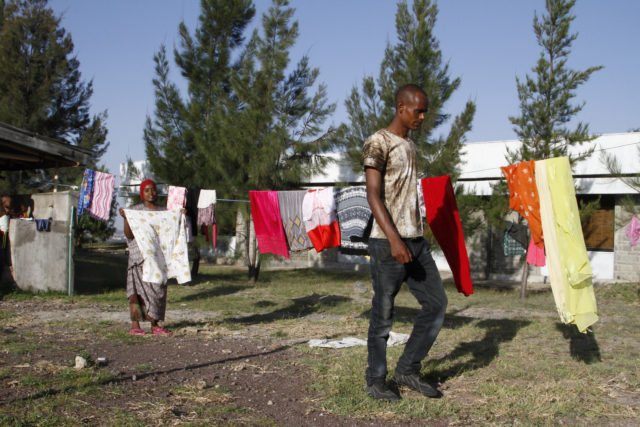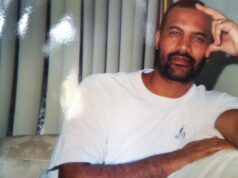
ADAMA, Ethiopia — A largely hidden war in remote areas of Ethiopia has killed hundreds of people, displaced more than 100,000 others and raised the specter of ethnic cleansing, potentially destabilizing an important U.S. partner in the fight against terrorism.
With the strongest army in the Horn of Africa and second-largest population on the continent, Ethiopia has been a major ally in battling regional terrorist groups such as al-Shabab and a pillar of stability between two disintegrating states, South Sudan and Somalia.
But that hard-earned reputation has been thrown in doubt by weeks of fighting between rival ethnic groups in Ethiopia’s neighboring Oromia and Somali regions and by accompanying reports of massacres and expulsions.
“They started to burn our houses, the Liyu police,” said Mohammed Nur Jamal of the Oromo ethnic group, referring to a paramilitary force from the neighboring Somali Region. With several dozen others, Jamal, a portly middle-aged man who wears an embroidered Muslim cap, now lives in a makeshift camp near the Oromo city of Adama. The camp is one of dozens that have sprung up to house those who have fled their homes.
“We lived like brothers and sisters for many years,” Jamal said. “We never fought like this. We even married together and owned properties together.”
Local media say at least 150,000 Oromos have been expelled from the Somali Region and are living in camps. The federal government has declined to give exact figures, pending an investigation, but admitted that “hundreds” have died.
The U.S. Embassy in Addis Ababa said in a Sept. 19 statement it was “disturbed by the troubling reports of ethnic violence and the large-scale displacement of people living along the border between the Oromia and Somali regions.” It called for an investigation into which groups were behind the violence.
Ethiopia, while long a centralized state, is made up of at least 80 different ethnic groups. Under an emperor and later a communist regime, it presented itself as a unified Amharic-speaking nation, with little attention paid to different ethnic groups with their own languages and histories.
In an attempt to recognize the aspirations of the country’s main ethnic groups, the rebel movement of Tigrayan ethnicity that overthrew the communist regime in 1991 reorganized Ethiopia into a federal state made up of nine ethnically defined regions with a degree of autonomy.
Two of those regions appear to be at war with each other. The nearly 1,000-mile border between the mainly agricultural Oromia Region and the more arid Somali Region has historically been the scene of minor conflicts over resources. But those tensions have exploded since September with allegations that regional security forces are involved, especially the Somali Region’s paramilitary “Liyu” (special) police.
Jamal, who had lived among the Somalis for 15 years, said the attacks took him by surprise. “There was hate, but it was hidden. They didn’t show it for many years because they were afraid of the federal government,” he said.
“Only Oromos are being targeted,” said Jaafar Mohammed, who spent 20 of his 25 years among the Somalis. “There are many other ethnic groups there — Somalis, Gurages, Amharas and others. But they targeted Oromos. It’s a puzzle for us.”
Mohammed said gangs attacked the Oromos and that he saw at least 20 people killed. He said he was hidden by a fellow Oromo at a local bank until he was able to sneak away to a camp close to a military base. He and other fleeing Oromos stayed there for a few days before trucks came to take them away. Even then, people hurled objects and insults at the trucks, and the Somali regional police stole the Oromos’ cellphones, people in the camp said.
“I would never return to the Somali region,” said Abdel Jabbar Ahmed, who fled with his family. “I am filled with tears when I try to recall what happened there. . . . A lot of people are hiding right now.”
Clashes and unrest were reported as far back as March and stem from dissatisfaction over a 2004 referendum that set the border. Over the past few months, several meetings brokered by the government were held with officials from both regions to resolve differences.
The strife is often linked to the competition for resources and arable land, especially with much of the Somali Region in the grip of a severe drought.
On Sept. 11, violence flared again after two Oromo officials arrested by Somali regional police turned up dead. In the ensuing Oromo protests, several Somalis were killed, sparking the widespread eviction of Oromos from Somali lands in retaliation.
Government spokesman Negeri Lencho said that those behind the violence would be prosecuted and that federal forces have been dispatched to restore peace.
“Psychologically, residents living around the borders are uncertain,” he said at a Sept. 25 news conference. “Some of them are frustrated about the security situation, although the government is doing its level best. . . . We can bring about a sustainable peace.”
Although the regional governments have pledged to return people to their homes, the displaced in Adama said they were being encouraged to find relatives to live with in the Oromia Region.
For now, they are housed in an unused office complex near the municipal headquarters on the edge of the city, where they sleep in bare rooms on thin foam mattresses surrounded by their belongings. At least half the camp’s several dozen residents are children. In other camps for the displaced across the country, thousands are being sheltered in converted warehouses.
Most of the displaced here arrived on trucks after a harrowing journey from the town ofTog Wajale in the Somali Region, near the border with Somalia, where they said neighbors they had known for years suddenly turned on them. Police went house to house and ordered all ethnic Oromos to leave as retaliation for the deaths of Somalis in the Oromia Region.
Amid the hostilities, the rival ethnic groups have accused each other of links to terrorism.
The central government’s perceived passivity in the face of the Oromos’ suffering has alienated the community’s politicians, said Fekadu Adugna, an expert on ethnicity and identity at Addis Ababa University. The whole region is just recovering from a year and a half of anti-government protests in which 1,000 people were killed by security forces.
A recently lifted 10-month state of emergency restored calm to the Oromia Region. But new demonstrations have broken out in the wake of the border clashes. On Oct. 11, security forces killed six protesters and wounded dozens.
“What the conflict is doing is increasing the mistrust between the political parties” from the different ethnic regions that make up the ruling coalition, Adugna said. “That mistrust can be a serious threat for the federal arrangement.”
On Sunday, Parliament Speaker Abadula Gammada — a former president of the Oromia Region and defense minister who once was one of the government’s most prominent Oromo allies — announced his resignation, saying his people and party have been “disrespected.”
In the Somali Region, Abdi Mohammad Omar, the regional president, is a staunch ally of the central government. And his Liyu police — aside from often being cited for human rights violations — have been effective in stamping out a rebel movement in the region.
Jan Abbink, an expert on Ethiopia at Leiden University in the Netherlands, warned that ethnicity-based policies tend to politicize communities and turn land disputes into ethnic conflicts. Whatever positive aspects the ethnic model offered when it was devised in 1992, he said, “I’m afraid . . . it is now not cooling tensions but it is fueling them.”
Many Ethiopians increasingly fear that these conflicts show the federal government is unable to control regional rivalries in this diverse country.
“No healthy country allows a mass displacement of this magnitude in the presence of a capable government,” said Assefa Fiseha, an expert on Ethiopian politics at Addis Ababa University. “What we have is rivalry among ethno-nationalist leaders who think the center is weaker than ever.”
























